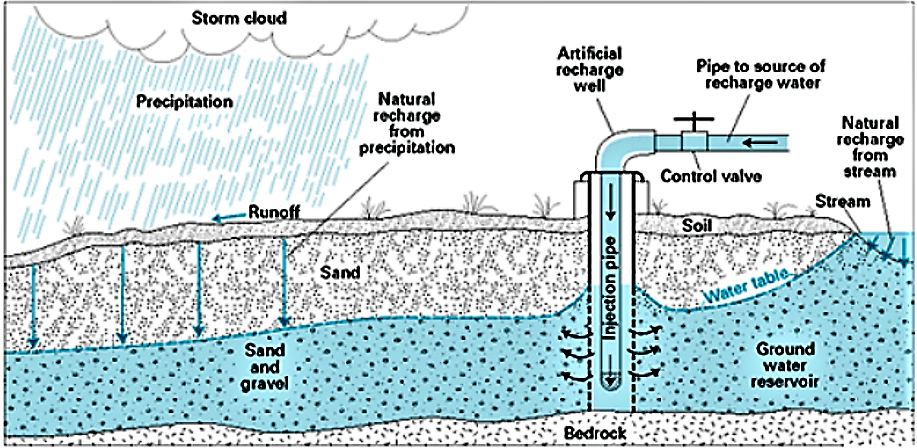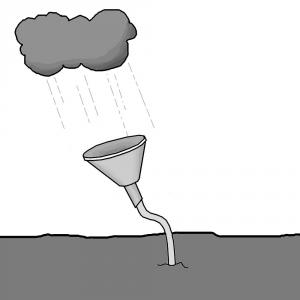Executive Summary
Artificial recharge is the planned, man-made increase of groundwater levels. By improving its natural replenishment capacities and percolation from surface waters into aquifers, the amount of groundwater available for abstraction is increased. This is particularly useful in areas where water and groundwater resources are heavily utilised and acute problems with dropping watersheds, soil salinisation, saltwater intrusion in coastal areas or water scarcity in general exist. Subsurface groundwater recharge refers to the different recharge techniques (generally injection or recharge wells) that release treated effluent and/or collected stormwater underground and directly replenish groundwater aquifers (without soil percolation).
| In | Out |
|---|---|
Freshwater |
Introduction
Artificial groundwater recharge is the planned infiltration of effluents from sanitation systems (e.g. waste stabilisation ponds, surface, horizontal flow or vertical flow constructed wetlands), stormwater or surface runoff into the aquifer in order to increase the natural replenishment of groundwater resources. Artificial subsurface groundwater recharge refers to recharge techniques (generally recharging wells) that release the water below the ground (as opposed to surface groundwater recharge where water percolates through the soil before entering the groundwater aquifer). Groundwater recharge is increasing in popularity as groundwater resources are being depleted and as saltwater intrusion is becoming a greater threat to coastal communities (TILLEY et al. 2008).
Although the primary objective of this technology is to preserve or restock groundwater resources, artificial recharge has been used for many other beneficial purposes. These include conservation or disposal of floodwaters, control of saltwater intrusion, storage of water to reduce pumping and piping costs as well as temporary regulation of groundwater abstraction. Furthermore water quality can be improved through the removal of suspended solids via soil filtration (see also surface groundwater recharge) or through the dilution with naturally occurring groundwater (ASANO 1985). Moreover artificial recharge is used in wastewater disposal, waste treatment, secondary oil recovery, prevention of land subsidence, storage of freshwater within saline aquifers, crop development and streamflow augmentation (OAKSFOARD 1985; UNEP 1998).
Basic Design Principles
Subsurface groundwater recharge, as opposed to surface water recharge does not provide any additional treatment through soil filtration. Therefore polluted wastewater should be treated before subsurface groundwater recharge. The effective and efficient operation of an artificial groundwater recharge system depends on the method of recharge, the characteristics of the aquifer, the residence time (hydrological study), the amount of blending with other waters and the history of the system. Careful analysis of these factors should precede any recharge project (TILLEY et al. 2008). For subsurface recharge, particularly the blending conditions must be studied carefully.
To avoid chemical reactions that would reduce aquifer porosity and recharge capacity, the recharge water must be chemically compatible with the naturally occurring groundwater and the aquifer material that it flows through. During operation, the quality (turbidity from sediments but also algae and bacteria, temperature, suspended solids, BOD, nitrogen and phosphorus, other chemicals, etc.) and quantity of the water to be recharged must be carefully controlled and monitored.
A variety of methods have been developed and applied to artificially recharge groundwater reservoirs in various parts of the world. Direct subsurface recharge methods can reach aquifers located at greater depth and require less land than direct surface recharge methods, but are more expensive to construct and maintain. Recharge wells, commonly called injection wells, are generally used to replenish groundwater resources when aquifers are located at greater depth and confined by materials of low permeability. All subsurface methods are prone to clogging because of suspended solids, biological activity or chemical impurities.
Recharge wells have been used to dispose of treated industrial wastewater, to add freshwater to coastal aquifers experiencing saltwater intrusion, and to force water under pressure into permeable bedrock aquifers to arrest land subsidence resulting from extensive withdrawals of groundwater, although with variable success (CGWB 1994). In many places, including the United States, Japan and Thailand, the use of injection wells is still considered experimental (UNEP 1998).
To ensure the effective and efficient operation of an artificial recharge system, a thorough and detailed hydro geological study must be conducted before selecting the site and recharge method. In particular, the following basic factors should be considered (UNEP 1998):
- Location of geologic and hydraulic boundaries
- Transmissivity of the overlying material
- Depth of the aquifer and lithology
- Storage capacity
- Porosity
- Hydraulic conductivity
- Natural in- and outflow of water to/from the aquifer
- Availability of land
- Surrounding land use and topography
- Quality and quantity of water to be recharged
- Economic and legal aspects concerning the recharge
- Degree of public acceptance
Subsurface Groundwater Recharge Wells
Recharge or injection wells are subsurface groundwater recharge techniques used to directly discharge water into deep water-bearing zones. Recharge wells can be cased with the material covering the aquifer. If this material is unconsolidated, a screen can be placed in the well in the zone of injection. Recharge wells are suitable only in areas where a thick impervious layer exists between the surface of the soil and the aquifer that is to be replenished. They are also advantageous in areas where land is scarce (as surface groundwater recharge requires large areas for infiltration). A relatively high rate of recharge can be attained with this method (O'HARE et al. 1986).

Groundwater recharge methods are particularly useful for aquifers with a long retention time, areas where water and groundwater resources are heavily utilised and acute problems with dropping watersheds, soil salinisation, saltwater intrusion in coastal areas or water scarcity in general exist.
The effectiveness of discharge into an aquifer will depend entirely on the quality and quantity of the water to be infiltrated, local environmental conditions (e.g. hydraulic conductivity, nutrient assimilation capacity of the receiving soil body) and legal regulations.
Dense urban and industrial concentrations may render subsurface recharge wells to inject surface water into the aquifers more interesting (UNEP 1998).
The physical, chemical and biological quality of recharge water also affects the selection of the recharge method. If suspended solids are present, surface application techniques tend to be more efficient than subsurface techniques that can result in clogging of injection wells. Water containing toxic chemicals or chemicals that could reduce aquifer porosity or recharge capacity must be pre-treated if used for artificial groundwater recharge.
Cultural considerations and socio-economic concerns often affect the selection of a recharge method and site. The availability of land, land uses in adjacent areas, public attitude and legal requirements generally play a role in defining the acceptability of artificial recharge in a given setting. In urban areas, where land availability, costs and uses in adjacent areas may impose restrictions, injection wells, shafts or small pits requiring highly controlled water supplies and little land area may be preferable to larger scale, surface spreading recharge methods. Surface recharge facilities generally require protected property boundaries, regular maintenance and continuous surveillance if they are to be accepted by the public.
Artificial Recharge of Groundwater
Manual on Artificial Recharge of Ground Water
Artificial Recharge: Methods, Hydraulics, and Monitoring
Compendium of Sanitation Systems and Technologies
This compendium gives a systematic overview on different sanitation systems and technologies and describes a wide range of available low-cost sanitation technologies.
TILLEY, E., LUETHI, C., MOREL, A., ZURBRUEGG, C. and SCHERTENLEIB, R. (2008): Compendium of Sanitation Systems and Technologies. Duebendorf, Switzerland: Swiss Federal Institute of Aquatic Science and Technology (EAWAG) and Water Supply and Sanitation Collaborative Council (WSSCC) URL [Accessed: 15.02.2010] PDFSourcebook of Alternative Technologies for Freshwater Augmentation in Some Countries in Asia (Technical Publication)
The Water Cycle – Infiltration
The Artificial Recharge of Groundwater
Recharge Of Groundwater
Groundwater recharge with recycled municipal wastewater: Criteria for health related guidelines
This article aims to highlight some principles related to aquifer recharge with recycled water, and to propose a simple approach to health related guidelines that take into account existing water regulations and guidelines.
BRISSAUD, F. (1999): Groundwater recharge with recycled municipal wastewater: Criteria for health related guidelines. France: Hydrosciences, MSE, Univ. Montpellier II, 34095 Montpellier Cedex 05Artificial Recharge and Rainwater Harvesting
Innovations in Groundwater Recharge. Water Policy Briefing. IWMI-TATA Water Policy Program
This brochure gives an overview on different low-cost aquifer recharge solutions based on the results from a 10-year pilot project in Uttar Pradesh. It indicates a practical and low-cost way to conserve and rejuvenate falling groundwater reserves.
IWMI (2002): Innovations in Groundwater Recharge. Water Policy Briefing. IWMI-TATA Water Policy Program. Vallabh Vidyanagar: International Water Management Institute URL [Accessed: 21.03.2019]Guide on Artificial Recharge to Groundwater
This document provides guidance on artificial recharge techniques and designs and the planning and monitoring of artificial recharge projects.
MINISTRY OF WATER RESOURCES (2000): Guide on Artificial Recharge to Groundwater. New Delhi: Central Ground Water Board URL [Accessed: 21.03.2019]Small Community Water Supplies: Technology, People and Partnership: Artificial Recharge - Chapter 6
This book provides a general introduction to a wide range of technologies. Among the topics covered are: planning and management of small water supplies, community water supplies in Central and Eastern European countries, water quality and quantity, integrated water resources management, artificial recharge, rainwater harvesting, spring water tapping, groundwater withdrawal, water lifting, surface water intake, water treatment, aeration, coagulation and flocculation, sedimentation, multi-stage filtration, desalination technology, disinfection, household level water treatment, technologies for arsenic and iron removal from ground water, and emergency and disaster water supply. Chapter 6: Artificial Recharge
SMET, J. ; WIJK, C. van (2002): Small Community Water Supplies: Technology, People and Partnership: Artificial Recharge - Chapter 6. The Hague: International Water and Sanitation Centre (IRC) URL [Accessed: 21.03.2019]Management of aquifer recharge and discharge processes and aquifer storage equilibrium
This paper draws attention to case studies from a range of hydro-geological, climatic and societal settings where innovative management has been successful in reversing groundwater storage declines (or increases). Informing and engaging stakeholders in governance has resulted in more resilient outcomes that take better account of local needs. Importantly, in many settings local action by motivated communities has run ahead of state and national policies and been highly effective in managing groundwater storage, increasing farm incomes and protecting the environment.
FAO GEF IAH IHP World Bank (2012): Management of aquifer recharge and discharge processes and aquifer storage equilibrium. Food and Agriculture Organization (FAO) URL [Accessed: 08.04.2013]Water Harvesting
Water harvesting has been practiced successfully for millennia in parts of the world – and some recent interventions have also had significant local impact. Yet water harvesting’s potential remains largely unknown, unacknowledged and unappreciated. These guidelines cover a wide span of technologies from large-scale floodwater spreading to practices that collect and store water from household compounds.
MEKDASCHI STUDER, R. LINIGER, H. (2013): Water Harvesting. Guidelines to Good Practice. Bern/Amsterdam/Wageningen/Rome: Centre for Development and Environment (CDE), Rainwater Harvesting Implementation Network (RAIN), MetaMeta, The International Fund for Agricultural Development (IFAD) URL [Accessed: 12.03.2019] PDFGroundwater recharge with recycled municipal wastewater: health and regulatory considerations
This case study on groundwater recharge with recycled wastewater focuses on quantifying possible health implications.
ASANO, T. COTRUVO, J. (2004): Groundwater recharge with recycled municipal wastewater: health and regulatory considerations. Davis: Department of Civil and Environmental Engineering, University of California URL [Accessed: 15.04.2011]Water and Community Development. Rainwater harvesting and groundwater recharge. A sustainable approach to human development at the global level
Article on rainwater harvesting and groundwater recharge in India and other countries.
DAVIES, R. ROY, B. (2004): Water and Community Development. Rainwater harvesting and groundwater recharge. A sustainable approach to human development at the global level. London: International Business Leaders Forum URL [Accessed: 22.03.2019] PDFArtificial Recharge of Groundwater
This website provides the online-version of the Sourcebook of Alternative Technologies for Freshwater Augmentation of the United Nations Environmental Programme (UNEP).

